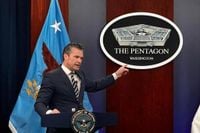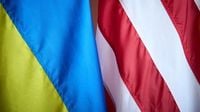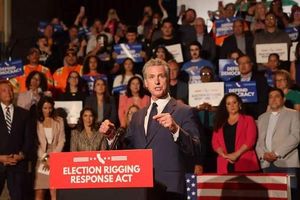For months, the Pentagon has quietly but decisively blocked Ukraine from using U.S.-supplied long-range Army Tactical Missile Systems (ATACMS) to strike targets inside Russia, a move that has sharply limited Kyiv’s defense options and become a flashpoint in the ongoing diplomatic struggle to end the war. According to The Wall Street Journal, this restriction—enforced since late spring 2025—has left Ukrainian commanders unable to hit Russian supply lines and strategic targets across the border, even as Moscow’s forces continue their grinding advance in eastern Ukraine.
The approval process behind this policy is as complex as it is secretive. As reported by multiple outlets, including NBC News and Reuters, the Pentagon now requires high-level sign-off for any Ukrainian request to use long-range weapons like ATACMS. This mechanism, quietly introduced by Deputy Secretary of Defense Elbridge Colby, means that every such request must land on the desk of Defense Secretary Pete Hegseth, who has the final say. According to officials cited by The Wall Street Journal, at least one Ukrainian request to target a site inside Russia was turned down, though details remain closely held.
These restrictions aren’t limited to American systems. The ban extends to British and French Storm Shadow/Scalp cruise missiles, which rely on U.S. targeting data. As a result, Ukraine’s ability to counter Russian aggression with Western-supplied long-range firepower has been narrowed just as the White House tries to coax the Kremlin into peace talks. The policy, as Ukrainian News Agency and SCMP note, essentially reverses a decision made by the Biden administration late last year that allowed Ukraine to strike Russian territory, reflecting a significant shift in Washington’s approach.
The rationale for this clampdown, according to U.S. officials, is rooted in diplomacy. President Donald Trump, now three years into the conflict that began with Russia’s invasion in February 2022, has grown increasingly frustrated with his inability to broker a ceasefire. Last week, Trump hosted Russian President Vladimir Putin in Alaska and Ukrainian President Volodymyr Zelenskyy, along with other European leaders, at the White House in a bid to hammer out a peace deal. The talks, however, ended without agreement. “I’m going to make a decision as to what we do, and it’s going to be a very important decision, and that’s whether or not it’s massive sanctions or massive tariffs or both, or we do nothing and say it’s your fight,” Trump declared on August 22, 2025, signaling a crossroads in U.S. policy.
White House Press Secretary Karoline Leavitt emphasized that Secretary Hegseth is working "in step with President Trump," reiterating the administration’s priority to end the war. “President Trump has made it clear that the war in Ukraine must end. There has been no change in the military posture between Russia and Ukraine at this time. Secretary Hegseth is working in step with President Trump,” Leavitt told reporters, according to The Wall Street Journal.
Trump’s frustration has spilled onto social media, where he vented about the limitations placed on Ukraine’s military. On August 21, 2025, he wrote, “It’s like a great team in sports that has a fantastic defense, but is not allowed to play offence. There is no chance of winning!” He further criticized his predecessor, stating, “Crooked and grossly incompetent Joe Biden would not let Ukraine FIGHT BACK, only DEFEND. How did that work out?” Despite the rhetoric, U.S. officials told The Wall Street Journal that Trump’s public statements do not signal an imminent policy change, though they acknowledge he could reconsider his stance on expanded offensive operations against Russia in the future.
The Pentagon and Ukrainian officials have largely declined to comment on the specifics of the approval process. However, the impact on Ukraine’s battlefield strategy has been clear. The inability to strike deep into Russian territory has limited Kyiv’s options, especially as Russian supply lines and infrastructure remain largely unscathed by Western-supplied long-range missiles. The review mechanism has also barred Ukraine from using British Storm Shadow missiles for cross-border strikes, as these systems depend on U.S. intelligence and targeting data.
In response, Ukrainian President Volodymyr Zelenskyy has signaled a pivot toward self-reliance. At a press conference with Canadian Prime Minister Mark Carney on Ukraine’s independence day, August 24, 2025, Zelenskyy asserted, “We haven’t been discussing such matters with the U.S. lately. At the moment, we are using our long-range domestically produced weapons.” This statement came after Russia claimed to have shot down Ukrainian drones over St. Petersburg and reported a large fire at a fuel terminal in the Ust-Luga port, allegedly targeted by Ukrainian drones.
The diplomatic stakes remain high. Trump’s failed attempt to arrange a bilateral meeting between Putin and Zelenskyy underscores the difficulty of forging a peace agenda. Russian Foreign Minister Sergei Lavrov told NBC News on August 22, 2025, “Putin is ready to meet with Zelenskyy when the agenda would be ready for a summit. And this agenda is not ready at all.” Meanwhile, European leaders are preparing for a meeting of the so-called "coalition of the willing"—thirty countries expected to gather on August 25, 2025, to discuss plans for a Europe-led peacekeeping force in Ukraine should a ceasefire be achieved.
Canada, for its part, has indicated it may be willing to send troops to help secure a peace deal. “In Canada’s judgment, it is not realistic that the only security guarantee could be the strength of the Ukrainian Armed Forces ... that needs to be buttressed and reinforced,” Prime Minister Carney said, leaving the door open to a possible Canadian military presence on Ukrainian soil. Yet, as The Telegraph reports, talks among coalition members have been hampered by a lack of clarity over the size and nature of each country’s proposed contribution.
European unity is also being tested. France summoned Italy’s ambassador after Italian Deputy Prime Minister Matteo Salvini made caustic remarks about French President Emmanuel Macron’s willingness to send troops to Ukraine. Germany’s foreign minister, Johann Wadepul, has admitted that the German military is likely too stretched to commit forces to Ukraine, highlighting the challenges facing any international peacekeeping effort.
As the war grinds on, the Pentagon’s current policy remains a key lever in Washington’s efforts to balance military support for Ukraine with the pursuit of a negotiated end to the conflict. Whether President Trump will ultimately stick with this strategy or pivot toward a more aggressive posture remains uncertain. For now, Ukraine’s ability to strike back at its aggressor is constrained by decisions made far from the front lines, with the world watching for the next move.





